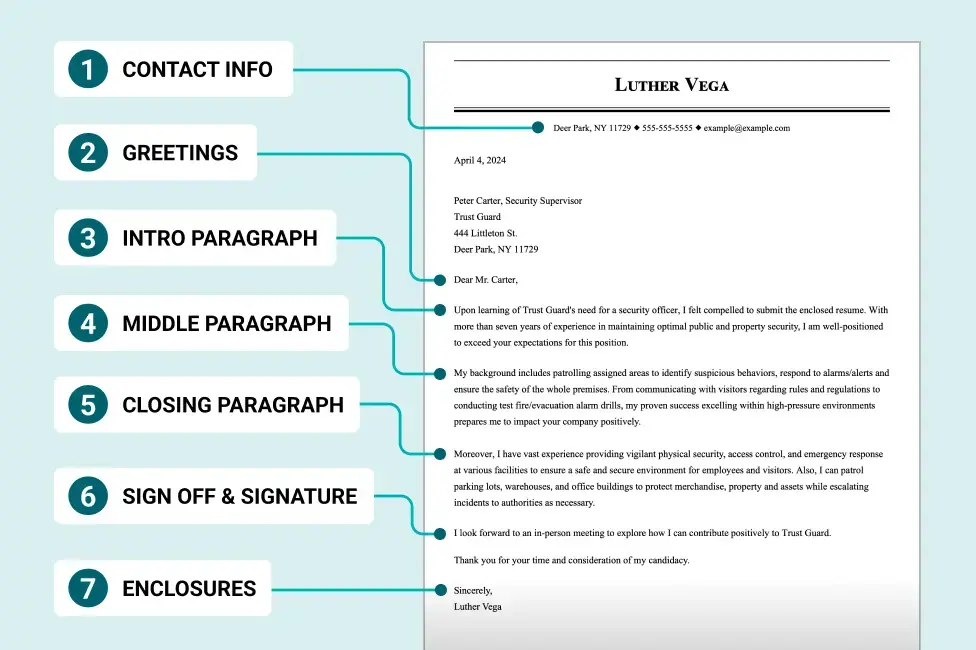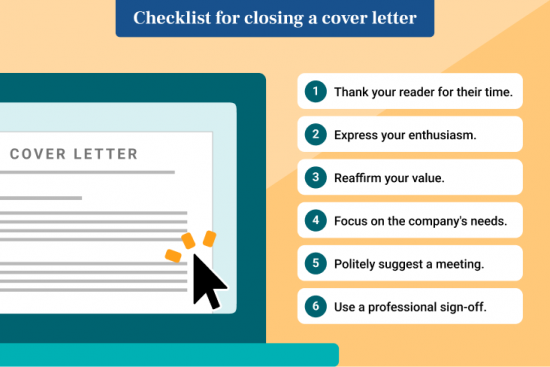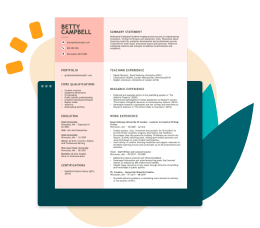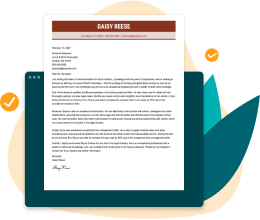What Is a Cover Letter? Definition & Best Examples (2025)
A cover letter is a one-page document you pair with a resume to land a job. This guide clearly defines a cover letter, its purpose, and how to write one, with examples and tips.
What Is a Cover Letter?
A cover letter is one of the documents that make up a standard job application. Along with a resume, the cover letter outlines key qualifications, experience, and motivations for a job.
A cover letter for a job application follows a standard business letter format. It should be professional in tone, and span no more than one page.
The cover letter’s format generally consists of three paragraphs. The first paragraph should introduce yourself. The second one must outline your career achievements and skills. Finally, the third one should function as a summary and a call to action for a job interview.
Here’s a visual example of how a good cover letter looks like:
Cover letter example
If you like this cover letter example, feel free to use our Cover Letter Generator to craft yours and customize it to your target job title and experience level; it just takes 15 minutes!
What Is The Purpose of a Cover Letter?
A cover letter’s purpose is to give job seekers a chance to personally introduce themselves and explain why they’re a strong fit for the role. It can complement your resume by adding context to your career path and highlighting key achievements.
While some debate the value of cover letters in today’s fast-paced job market, many employers still require or strongly encourage them. Ignoring the cover letter submission requirement can cost you the opportunity entirely. Even when stated as optional, including a cover letter shows initiative and genuine interest, which can set you apart.
Provided this context, there are quite a few key benefits of writing a cover letter for a job application.
Why include a cover letter?
- Introduces you personally and explains your interest in the role and company.
- Highlights key skills and achievements that align with the job requirements.
- Provides context for your resume, such as career changes, gaps, or relocation.
- Demonstrates communication skills and professionalism.
- Shows initiative and enthusiasm, helping you stand out from other applicants.
- Allows you to tailor your message specifically to the job and employer.
Depending on your career situation and context, your cover letter can meet various purposes. We’ve organized cover letters into four key types that meet common job seeker needs.
Check out cover letter samples for the four most common purposes below:
Four types of cover letters for different career scenarios
1
Cover letter for a job application
A cover letter for a job application is the most common letter type, typically submitted alongside your resume. Its purpose is to express your interest in a specific position, explain why you’re a strong fit, and share relevant parts of your career story.
The key to writing a cover letter for a job is to tailor it to each specific job opening. It can also address details not included in your resume, such as employment gaps or a career change, to give employers a fuller picture of your background.
2
Referral cover letter
A referral cover letter is a type of application letter that mentions a current or former employee who referred you for the position. You should highlight this connection in the opening paragraph to show that someone within the company endorses you, which can strengthen your credibility and boost your chances of landing an interview.
When writing a referral cover letter, be sure to include the referrer’s name, explain your relationship, and briefly highlight why you’re a strong fit for the role. Always ask the person’s permission before mentioning them, so they’re prepared to speak on your behalf if needed.
3
Letter of interest
A letter of interest, also known as a prospecting or “cold call” cover letter, helps job seekers inquire about potential job opportunities at a company that hasn’t posted an open position. Its purpose is to express genuine enthusiasm for the organization and demonstrate how your background aligns with its mission.
When writing one, highlight your connection to the company, explain why you want to be part of the team, and showcase relevant skills or experience that could add value—even if there’s no current opening.
4
Networking cover letter
A networking cover letter is sent to professional contacts—such as colleagues, mentors, or industry connections—to express your interest in a specific role or job search in general. Its purpose is to share your resume and cover letter with someone who might refer you or pass your materials along to a hiring manager. Think of it as a mix between a referral and a prospecting letter.
When writing a networking letter, briefly explain the type of opportunity you’re seeking, why you’re reaching out to that particular contact, and include a clear request for them to share your information if they know of relevant openings.
What to Include in a Cover Letter?
A well-structured cover letter follows a simple format and includes the essential elements below. Each part works together to present your qualifications clearly and professionally.
- Your contact information
Include your name, phone number, email address, and city and state at the top of the letterhead.
- The employer’s details
Right after including the date, add the hiring manager’s name (if known), their title, the company name, and its address.
- A professional greeting
Whenever possible, address the letter to a specific person (e.g., “Dear Ms. Patel”). If you can’t find a name, use a general but polite greeting like “Dear Hiring Manager.”
- Body paragraphs
- Start with a strong opening that states the position you’re applying for and expresses enthusiasm.
- In the middle paragraphs, highlight your most relevant achievements and explain how your background aligns with the job.
- Use this space to expand on points from your resume and provide context for career changes or employment gaps.
- End with a confident closing that expresses your interest in an interview and appreciation for the reader’s time.
- Sign-off and signature
Use a polite closing phrase such as “Sincerely” or “Best regards,” followed by your full name. If you’re submitting a physical letter, leave space for your handwritten signature above your typed name.
- Enclosures (if applicable)
If you’re including additional documents, such as, a portfolio, writing sample, or references, make note of this at the end of your letter with a line like:
Enclosures: Resume, Graphic Design Portfolio
Writing a cover letter can feel challenging, but you don’t have to do it alone. If you’re unsure how to get started or want a polished letter that highlights your strengths, our career experts are here to help. We offer professional cover letter writing services to create a compelling, customized letter that gets results.
How to Write a Good Cover Letter
A great cover letter should feature the most helpful experiences and skills you have for the open position. Here are tips for what to say in your cover letter:
1
Target the job’s needs from the ad.
Pay close attention to the job post or description and pick out specific keywords the employer uses. Then, give details about your work experience that help prove you can execute the job duties and have the right skills. Targeting an employer’s core needs will help you dazzle and impress them!
Example targeting the job post needs in your cover letter:
Key responsibilities (from job post)
- Manage and maintain executive calendars, scheduling appointments, and meetings.
- Draft and edit documents, reports, and correspondence.
- Basic computer skills, including word processing software and spreadsheets.
- Handle phone calls, emails and inquiries, directing them as needed.
Targeted cover letter response:
2
Include numbers or percentages to grab attention.
Numbers speak louder than words when it comes to proving your abilities. So, it’s helpful to try and feature flattering career statistics you’ve achieved and weave them into a story where the numbers result from a problem you solved.
Example of measurable achievements on a cover letter:
3
Explain why you want to work at the company.
Employers want people who are passionate about their work. So, you’re more likely to get hired if your cover letter expresses sincere interest in the job’s duties or the company’s overall mission. If you have a personal connection to the business, share it!
Example of showing personal connection in a cover letter:
4
Include a polite call to action at the end of your letter.
In the closing paragraph, show grace and follow through by thanking the reader for their time. Then, make a “call to action” by suggesting a future talk. The goal here is to reaffirm your interest in the role and end the letter politely and pleasantly.
Example of a cover letter’s call to action:
Cover Letter Templates
Templates are pre-formatted documents that you can use to ensure your cover letter includes all the necessary information; it’s like a fill-in-the-blanks. Plus, they’re designed by graphic designers so that your cover letter has that professional look!
You can select a professional design from our library of cover letter templates.
Free cover letter template
[Name]
[City/state location]
[Phone number]
[Professional email address]
[Company name]
[Company address]
Dear [Hiring manager’s name],
[Show excitement for the position and mention the job title you want]. [Explain why you’re applying for the role, what top skills you bring to the table and how you plan to contribute to the success of their mission].
[Cite your relevant experience and qualifications]. [Highlight one-to-two relevant achievements and try to tell a story about them]. [Confirm you’d be a good fit for the company by responding to their needs in the job post or ad]. [Optional: Address reason for employment gap or career transition].
[Thank your reader]. [Restate your interest in the role]. [Express desire to meet or talk about the opportunity].
[Closing sign off],
[Your name]
[Optional: Add an “Enclosures:” list here if you include any documents beyond your resume, like a portfolio or writing sample.]
Key Takeaways
- A cover letter is a one-page document that complements your resume and helps you stand out by highlighting your interest in the role and relevant qualifications.
- There are four types of cover letters you can write: for job applications, when you have an employee referral, networking, and a letter of interest, each tailored to different situations.
- A strong cover letter includes your contact information, a greeting, three to four concise body paragraphs, a professional sign-off, and mentions of any enclosures if applicable.
- Customizing your cover letter to each job and employer shows initiative and can significantly boost your chances of getting an interview.
- A cover letter is the perfect place to explain gaps between jobs or why you’re making a career change. So, if either of these situations apply to you, try to address it in your letter. It will help employers see you in a positive light.
- Make sure to keep your cover letter free of errors! Any spelling or grammar mistakes show a lack of care and could cost you the job. So, be sure to run your letter through a proper grammar check!
Ready to start building your cover letter? Get a personalized letter tailored to your unique job title and writing style with our Cover Letter Generator.
Featured in:*

*The names and logos of the companies referred to in this page are all trademarks of their respective holders. Unless specifically stated otherwise, such references are not intended to imply any affiliation or association with LiveCareer.













